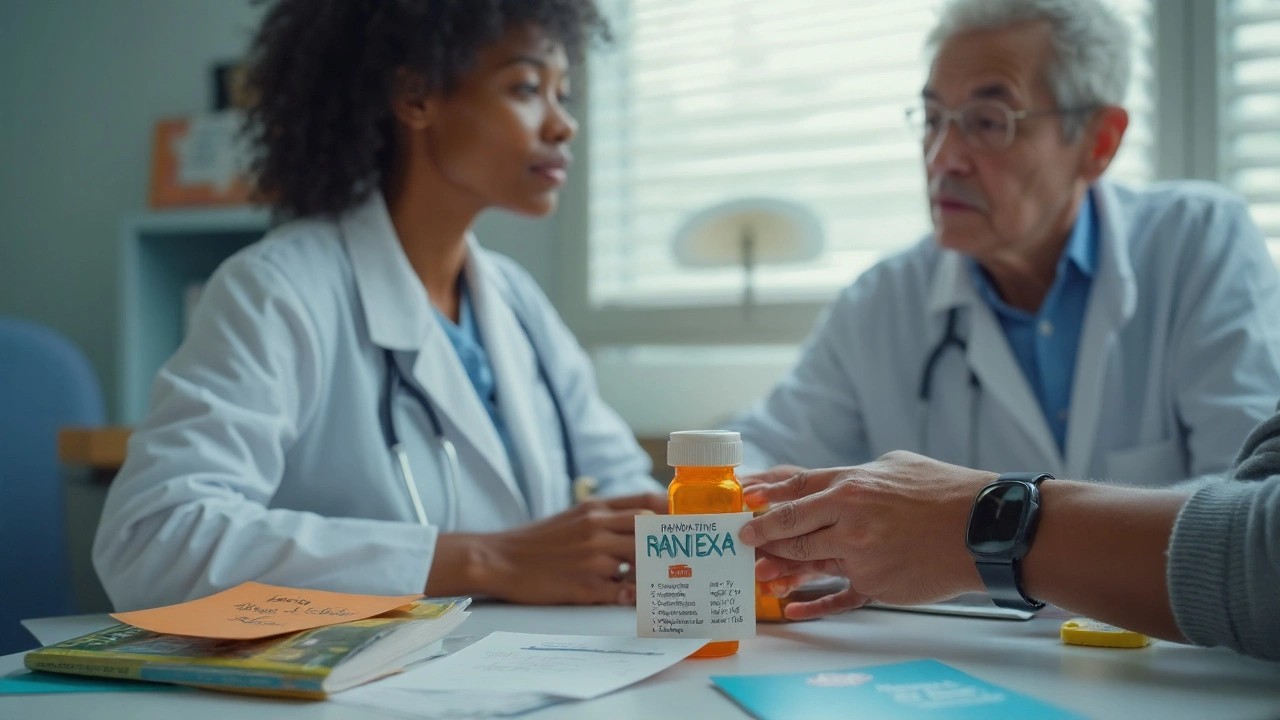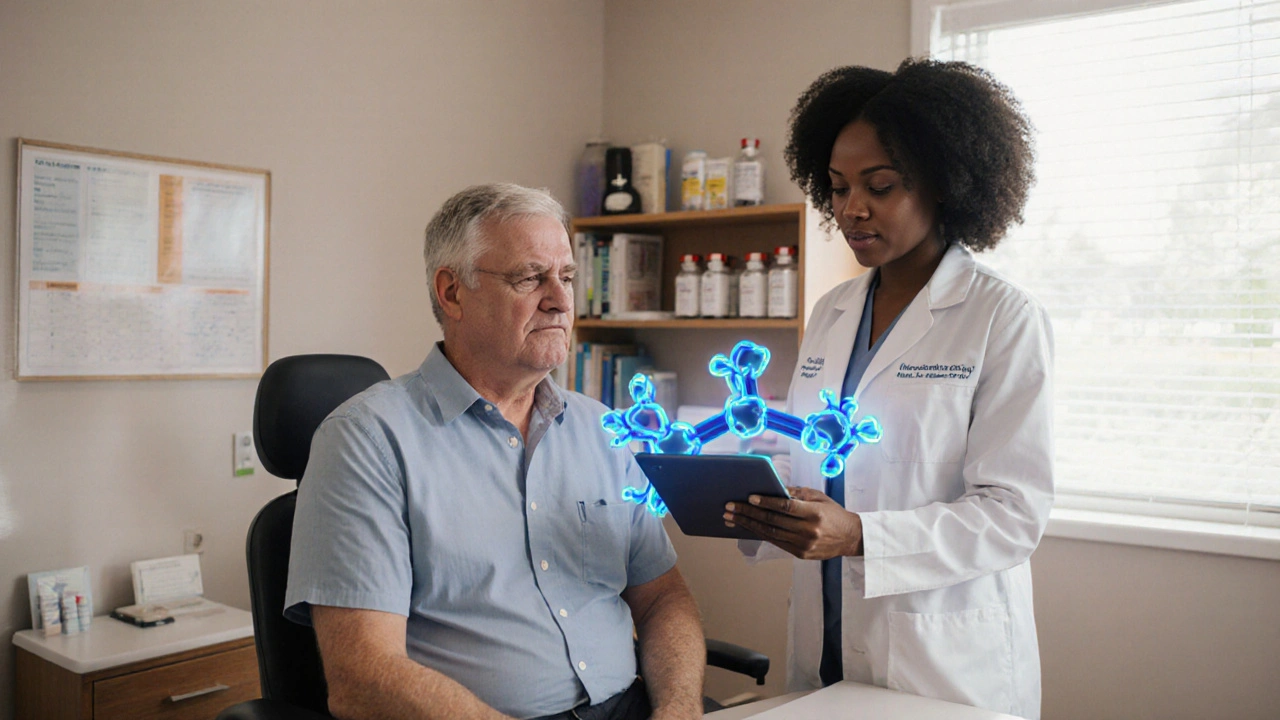Chest tightness stealing your walks? A lot of people with chronic angina hit a wall when beta blockers or nitrates drop their blood pressure or slow their heart too much. Ranolazine steps in differently. It eases angina without changing heart rate or blood pressure much. It is not a rescue pill for sudden chest pain, but when used daily, it can mean fewer stops on that hill up to the lookout. That has been my reality in windy Wellington, where every climb tests the ticker.
- It treats chronic angina symptoms; it does not stop a heart attack or fix blocked arteries.
- Usual dose: 500 mg twice daily, then 1000 mg twice daily if needed and tolerated.
- Key risks: QT prolongation on ECG, drug interactions (especially with CYP3A inhibitors/inducers), avoid in severe liver disease.
- Good pick if your BP or pulse runs low and other angina drugs are limited.
- Evidence shows fewer angina attacks and longer exercise time; no proven survival benefit.
What it is, how it works, and who it helps
Ranexa is the brand for ranolazine, a prescription drug for chronic stable angina. It is an extended-release tablet you take twice daily. It works by inhibiting the late sodium current in heart muscle. That lowers intracellular sodium and calcium, eases diastolic wall stress, and improves myocardial relaxation. The cool part: it does this with minimal effect on heart rate and blood pressure, so it often helps when you cannot push beta blockers or calcium channel blockers any higher.
What Ranexa does well:
- Reduces the number of angina episodes per week.
- Improves exercise duration before chest pain kicks in.
- Works as add-on therapy when first-line drugs are limited by low BP or slow pulse.
What it does not do:
- It does not relieve acute chest pain (not a nitro replacement).
- It does not open clogged arteries.
- It has not shown a reduction in heart attacks or death in large outcome trials.
Evidence you can trust:
- CARISA (JAMA 2004): On top of atenolol, diltiazem, or amlodipine, ranolazine extended exercise time by roughly 20-30 seconds and cut angina frequency.
- ERICA (Am J Cardiol 2006): Added to amlodipine 10 mg, ranolazine reduced weekly angina episodes and nitro use.
- MERLIN-TIMI 36 (JAMA 2007): In patients with acute coronary syndromes, no drop in cardiovascular death or MI, but less recurrent ischemia episodes on monitoring and fewer angina symptoms over time.
Who is a good candidate:
- People with chronic stable angina whose symptoms persist despite beta blockers or calcium channel blockers.
- Those who cannot tolerate higher doses of other drugs because of low blood pressure or bradycardia.
- People already on long-acting nitrates who still have symptoms.
Who should avoid or use extreme caution:
- Severe liver disease: contraindicated.
- Known long QT syndrome or taking multiple QT-prolonging drugs.
- Strong CYP3A inhibitors (for example: ketoconazole, clarithromycin, ritonavir) or inducers (for example: rifampin, St. John’s wort) - do not combine.
- Severe kidney impairment: higher risk of adverse effects; not studied in dialysis.
I remember adjusting a neighbor’s expectations after their cardiology visit: “It won’t give instant relief,” I said, “but in a week or two, that walk from Lyall Bay to the hilltop should feel less like a sprint up a sand dune.” They nodded; the daily nibbles of life matter more than any single dramatic moment.
| Drug facts | Key details |
|---|---|
| Generic / Brand | Ranolazine / Ranexa |
| Indication | Chronic stable angina (symptom relief) |
| Formulation | Extended-release tablets: 500 mg, 1000 mg |
| Starting dose | 500 mg twice daily |
| Max dose | 1000 mg twice daily (or 500 mg twice daily with moderate CYP3A inhibitors) |
| Time to steady state | About 3 days |
| Half-life (ER) | 6-9 hours |
| Metabolism | Hepatic (CYP3A major, CYP2D6 minor), P-gp substrate |
| ECG effect | Mild QT prolongation; dose-related |
| Common side effects | Dizziness, constipation, nausea, headache |
| Serious risks | Marked QT prolongation/arrhythmia (rare), renal function changes, hypersensitivity |
Sources: FDA Prescribing Information (latest label updates through 2023), American College of Cardiology/American Heart Association Chronic Coronary Disease Guideline (2023), European Society of Cardiology Chronic Coronary Syndromes Guideline (2019), CARISA, ERICA, and MERLIN-TIMI 36 trials.

How to take it safely: dosing, side effects, interactions, and monitoring
Daily routine matters with ranolazine. Set up a simple plan and give it time to work.
Step-by-step dosing:
- Start with 500 mg twice daily. Take at the same times each day.
- After 2-4 weeks, if symptoms persist and you feel fine, your clinician may increase to 1000 mg twice daily.
- Do not crush, chew, or split the tablets. They are extended-release. Swallow whole.
- With food or without food is fine. Pick a pattern and stick with it to avoid missed doses.
Special dosing rules with interacting drugs:
- On diltiazem, verapamil, or erythromycin (moderate CYP3A inhibitors)? Keep ranolazine at 500 mg twice daily.
- Taking strong CYP3A inhibitors (ketoconazole, clarithromycin, ritonavir, itraconazole) or inducers (rifampin, carbamazepine, phenytoin, St. John’s wort)? Do not use ranolazine.
- Grapefruit or grapefruit juice can raise levels. Best to avoid.
Important drug-drug interactions to know cold:
- Metformin: ranolazine can raise metformin levels. Many clinicians cap metformin at about 1700-2000 mg/day when combined; watch for GI upset or B12 issues.
- Simvastatin: exposure goes up; limit simvastatin to 20 mg/day. Consider switching to pravastatin or rosuvastatin if you need higher potency.
- Digoxin: levels can increase (P-gp). Your clinician may check a level after starting or adjusting ranolazine.
- Antiarrhythmics and QT-prolonging meds (for example amiodarone, sotalol, dofetilide, certain antipsychotics, macrolides): combined QT effects add up. Get a baseline ECG and repeat after titration.
- Warfarin and direct oral anticoagulants: no strong direct signal, but review the full list with a pharmacist since polypharmacy can get messy.
Side effects you might feel, and what to do:
- Dizziness or lightheadedness: common, usually settles. Stand up slowly, hydrate, and mention it if it lingers.
- Constipation: add fibre, fluids, and movement; a gentle stool softener for a week can help.
- Nausea/indigestion: smaller meals, avoid heavy or spicy food; taking at the same time each day helps.
- Headache: often mild; if it persists, ask about dose adjustment.
Less common but important:
- Palpitations, fainting, or severe dizziness: check an ECG quickly.
- Allergic reaction (rash, swelling, trouble breathing): urgent care.
- Noticeable worsening of kidney numbers: your clinician may pause or lower the dose.
Kidney and liver considerations:
- Liver disease: avoid in moderate to severe impairment; risk of significant QT changes.
- Kidney disease: more side effects at lower GFR; dose carefully and monitor. Not recommended in dialysis due to limited data.
Practical tips that keep people on track:
- Use a weekly pill box and set two alarms per day. Sounds simple. Works.
- Keep a symptom diary: date, activity, angina intensity (0-10), and nitro use. Bring this to your follow-up.
- Ask for a baseline ECG before starting, then another after you hit your stable dose, especially if you take any QT-prolonging meds.
- Keep potassium and magnesium in range. Low electrolytes raise arrhythmia risk.
- Carry your short-acting nitroglycerin for sudden chest pain. Ranolazine is not a rescue med.
Missed dose rules:
- If you miss a dose by a few hours, take it when you remember.
- If it is close to the next dose, skip the missed one. Do not double up.
When to call your clinician:
- New or more frequent chest pain, especially at rest or at night.
- Fainting, new palpitations, or anything that feels like an electrical storm in your chest.
- Any new drug added to your list that could interact (antibiotics, antifungals, seizure meds, HIV antivirals).
One home truth from our place: my wife, Tamsin Rowell, keeps a whiteboard on the fridge with meds and times. It makes it easier for both of us to spot any changes the moment a new prescription shows up.

Alternatives, comparisons, costs, and the questions everyone asks
Where does ranolazine fit among other angina options? Think of it as an add-on once the basics are in play.
First-line drugs and how ranolazine compares:
- Beta blockers (for example metoprolol): reduce heart rate and oxygen demand; strong evidence for symptom relief and post-MI benefit. Problem: can cause fatigue, erectile issues, and bradycardia. Ranolazine does not slow the heart, so it works when bradycardia limits beta blockers.
- Calcium channel blockers: dihydropyridines (for example amlodipine) reduce afterload; non-dihydropyridines (diltiazem, verapamil) reduce heart rate and contractility. Ranolazine pairs well with amlodipine; use caution with diltiazem/verapamil due to interactions.
- Nitrates (isosorbide mononitrate): reduce preload and wall stress; tolerance can develop; headaches are common. Ranolazine can lower nitro use, which many people appreciate.
Other options and regional caveats:
- Ivabradine: reduces heart rate via the If current. In some regions it is used for angina; in others it is mainly for heart failure. Not a nitrate; watch resting heart rate.
- Nicorandil, trimetazidine: used in some countries for angina; availability varies.
- Revascularization (stents or bypass): for anatomy-driven relief and outcomes when appropriate. Meds still matter after procedures.
Which to choose when:
- Low blood pressure or pulse limits: ranolazine often wins as the next add-on.
- High angina burden despite two drugs: add ranolazine if ECG and interactions allow.
- Multiple QT-prolonging meds on board: look first for alternatives, then use ranolazine only with careful ECG monitoring if you must.
Costs and access (2025):
- Generic ranolazine is available in many countries and often much cheaper than the old brand used to be.
- Prices swing a lot by pharmacy and insurer. Ask your pharmacist to check discount programs or patient assistance.
- Availability and subsidy differ by region. In New Zealand, check current Medsafe registration and Pharmac subsidy status with your GP or pharmacist, as these can change. Private purchase may be needed if not subsidised.
Simple decision checklist before starting ranolazine:
- Do you have chronic stable angina despite standard therapy?
- Any history of long QT, severe liver disease, or on strong CYP3A inhibitors/inducers? If yes, stop and reconsider.
- Can you get a baseline ECG and basic labs (electrolytes, kidney, liver)?
- Do your current meds include simvastatin, metformin, digoxin, or diltiazem/verapamil? Plan adjustments.
- Do you understand it is not a rescue pill? Carry nitro for flare-ups.
Mini‑FAQ
- Is ranolazine a blood thinner? No. It affects heart muscle metabolism/electrophysiology, not clotting.
- Can I take it with sildenafil or tadalafil? Ranolazine is not a nitrate, so there is no direct dangerous interaction like with nitroglycerin. Still, talk with your clinician to make sure your heart status and blood pressure can handle it.
- Can I stop ranolazine suddenly? It is not known for rebound effects, but your angina may flare if you stop. Best to taper under guidance.
- Does it help atrial fibrillation? Not an approved use. Some studies suggest small antiarrhythmic effects, but it is not a standard AF treatment.
- Will I need blood tests? Not for the drug itself, but checking electrolytes, kidney and liver function, and an ECG is smart.
- Is it safe with chronic kidney disease? Use with care. Risk of side effects rises as kidney function drops. Not studied well in dialysis.
- Can I drink alcohol? Light to moderate intake is usually fine, but heavy drinking raises arrhythmia risk and can worsen angina. Keep it modest.
Common troubleshooting paths
- Still getting angina after two weeks at 500 mg twice daily: if no side effects, ask about increasing to 1000 mg twice daily. Confirm no new interactions slipped in.
- Dizziness that will not quit: check blood pressure, review other meds (especially those that lower BP), consider stepping down the dose or switching strategy.
- New palpitations after dose increase: get an ECG. Check potassium and magnesium. Reassess other QT-prolonging drugs.
- On metformin and feeling more GI upset: review the total daily metformin dose; lowering it a notch often fixes it.
- Cholesterol meds out of balance: if you need high-intensity statin therapy, consider rosuvastatin or atorvastatin rather than higher-dose simvastatin with ranolazine.
What to do next
- Write down your angina pattern for one week: number of episodes, triggers, nitro use, and effort level. This helps decide if you need ranolazine or a dose change.
- Bring a full medication list to your clinician, including supplements and over-the-counter items. Mention any grapefruit habits.
- Ask for a baseline ECG and electrolyte panel before or shortly after starting.
- Schedule a follow-up 2-4 weeks after any dose change to check symptoms and side effects.
- If chest pain changes character (at rest, longer, or with sweating/nausea), call urgent care. Do not wait for a routine visit.
A quick word on expectations: most people who benefit notice fewer angina episodes within the first week or two as levels reach steady state. You measure success not in fanfare, but in ordinary wins - making it up the steps in one go, finishing the grocery run without stopping, saying yes to that coastal walk on a breezy Saturday without mapping every bench along the way.
References for clinicians: FDA Prescribing Information (ranolazine extended-release), ACC/AHA Chronic Coronary Disease Guideline 2023, ESC Chronic Coronary Syndromes Guideline 2019, CARISA (JAMA 2004), ERICA (Am J Cardiol 2006), MERLIN-TIMI 36 (JAMA 2007). These set the dose rules, interaction limits, and the role of ranolazine in modern angina care.



OMG this is *everything* I’ve been screaming into the void about!! 🥹 Ranolazine is the unsung hero of angina management-like the quiet librarian who knows every secret in the cardiology stack. No BP crash? No bradycardia? SIGN ME UP. I’ve been on 1000mg BID since last fall and now I can actually climb stairs without feeling like I’m being strangled by a boa constrictor. Also, Tamsin’s whiteboard? ICONIC. I started one too. Now my cat knows my meds better than I do. 🐱💊
Ugh. Another overhyped drug pushed by Big Pharma while real solutions like diet and exercise get ignored. This is why America’s heart disease crisis is out of control-people want magic pills instead of taking responsibility. Ranolazine? More like Ran-oh-nothing. You’re still gonna die if you eat junk and sit on your butt all day. Stop medicating laziness. 🇺🇸
YESSSS this is the kind of practical, no-fluff guide we need!! 🙌 You didn’t just dump data-you gave us a roadmap. That symptom diary tip? GAME CHANGER. I’ve been telling my patients for years: write it down. If you can’t track it, you can’t improve it. And the ‘walk without mapping every bench’ line? That’s poetry. Keep this energy alive. You just made someone’s Monday better. 💪❤️
Really appreciate this post-especially the part about New Zealand and Pharmac subsidies. I’m from Mexico City and we don’t have ranolazine covered here, but I’ve seen patients struggle with the same issues. The cultural context matters. In my clinic, we call it ‘the quiet helper’ because it doesn’t scream for attention like nitrates or beta blockers. Also, typo: ‘diltiazem/verapamil’ should be ‘diltiazem or verapamil’-but I get it, typing fast on a phone. 😊
This is a well-structured and clinically accurate overview. The distinction between symptom relief and mortality benefit is clearly articulated, which is often lost in patient-facing materials. The inclusion of trial names and dosing nuances demonstrates a commendable level of rigor. Well done.
Thank you for the comprehensive and meticulously referenced summary. The adherence to evidence-based guidelines, particularly the ACC/AHA and ESC recommendations, is both refreshing and necessary. I would only respectfully suggest adding a footnote regarding the 2024 meta-analysis by Gupta et al. on QT prolongation risk stratification in patients with moderate renal impairment, as it offers updated risk stratification thresholds not fully captured in the 2023 guidelines referenced. Your clarity and precision are exemplary.
Let me tell you something about ranolazine’s mechanism-it’s not just about sodium channels, bro. It’s about the heart’s metabolic flexibility. The late sodium current? That’s the sneaky little glitch in the cardiac action potential that causes calcium overload during diastole, right? And when you block it, you’re essentially telling the myocardium: ‘Hey, chill out, stop overworking, relax your walls.’ That’s why it doesn’t drop BP or HR-it’s not a vasodilator or chronotrope, it’s a metabolic modulator. Think of it like tuning a car engine to run leaner under stress, not revving it less. The CARISA trial? Yeah, 20-30 seconds extra exercise time sounds tiny, but when you’re 72 and your lungs feel like wet paper bags, that’s the difference between watching your grandkid’s soccer game and sitting on the bench. And the drug interactions? Oh honey, if you’re on ketoconazole or clarithromycin and still taking ranolazine, you’re basically playing Russian roulette with torsades. And don’t even get me started on grapefruit juice-it’s not just a warning, it’s a death sentence waiting for a CYP3A enzyme to show up. I’ve seen it. Twice. So yeah, this isn’t just a pill. It’s a precision tool. Handle it like one. And if you’re on metformin? Watch those B12 levels. Ranolazine doesn’t just raise metformin-it makes your mitochondria feel like they’re stuck in a traffic jam. Long-winded? Maybe. But this stuff saves lives, not just symptoms.